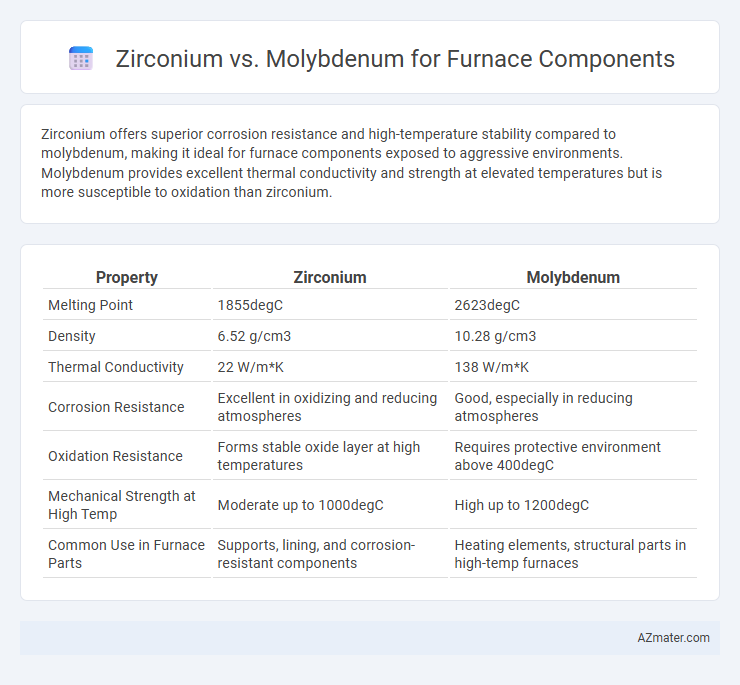Zirconium offers superior corrosion resistance and high-temperature stability compared to molybdenum, making it ideal for furnace components exposed to aggressive environments. Molybdenum provides excellent thermal conductivity and strength at elevated temperatures but is more susceptible to oxidation than zirconium.
Table of Comparison
| Property | Zirconium | Molybdenum |
|---|---|---|
| Melting Point | 1855degC | 2623degC |
| Density | 6.52 g/cm3 | 10.28 g/cm3 |
| Thermal Conductivity | 22 W/m*K | 138 W/m*K |
| Corrosion Resistance | Excellent in oxidizing and reducing atmospheres | Good, especially in reducing atmospheres |
| Oxidation Resistance | Forms stable oxide layer at high temperatures | Requires protective environment above 400degC |
| Mechanical Strength at High Temp | Moderate up to 1000degC | High up to 1200degC |
| Common Use in Furnace Parts | Supports, lining, and corrosion-resistant components | Heating elements, structural parts in high-temp furnaces |
Introduction to Furnace Component Materials
Furnace components require materials with exceptional high-temperature strength, corrosion resistance, and thermal stability, making zirconium and molybdenum prime candidates in industrial applications. Zirconium offers superior resistance to chemical attack and excellent oxidation resistance at moderate temperatures, while molybdenum excels in maintaining mechanical strength and creep resistance at extreme temperatures above 1000degC. Selecting between zirconium and molybdenum for furnace components depends on specific operational environments, including exposure to corrosive atmospheres and thermal cycling conditions.
Overview of Zirconium in Furnace Applications
Zirconium is highly valued in furnace components due to its excellent resistance to high-temperature corrosion and oxidation, making it ideal for use in extreme thermal environments. Its low thermal neutron absorption cross-section also benefits applications requiring nuclear-grade materials in furnace linings. Zirconium alloys provide superior mechanical strength and thermal stability compared to molybdenum, enhancing durability and performance in high-stress furnace conditions.
Overview of Molybdenum in Furnace Applications
Molybdenum is highly valued in furnace applications for its exceptional high-temperature strength and resistance to thermal expansion, making it ideal for components such as heating elements and structural supports. Its excellent oxidation resistance extends operational lifespan in harsh environments, outperforming many other refractory metals including Zirconium. Due to superior thermal and mechanical properties, molybdenum ensures enhanced efficiency and durability in industrial furnace settings.
Thermal Properties: Zirconium vs Molybdenum
Zirconium exhibits excellent thermal conductivity and maintains stability at high temperatures, making it suitable for furnace components exposed to rapid thermal cycling. Molybdenum offers superior high-temperature strength and a higher melting point of 2623degC, outperforming zirconium's melting point of 1855degC in extreme temperature environments. Both materials resist thermal expansion and oxidation; however, molybdenum's thermal stability and lower thermal expansion coefficient enhance its performance in prolonged high-temperature furnace operations.
Mechanical Strength and Durability Comparison
Zirconium exhibits superior corrosion resistance and high-temperature mechanical strength, making it highly durable for furnace components exposed to aggressive environments. Molybdenum offers excellent creep resistance and maintains structural integrity at elevated temperatures, ensuring long-term durability under thermal stress. When comparing mechanical strength, molybdenum typically surpasses zirconium in tensile strength at extreme heat, but zirconium's enhanced oxidation resistance often leads to greater overall component lifespan in corrosive atmospheres.
Corrosion and Oxidation Resistance
Zirconium exhibits superior corrosion resistance compared to molybdenum, particularly in acidic and highly corrosive environments typical of furnace components, due to its stable oxide layer that prevents further degradation. Molybdenum offers excellent oxidation resistance at high temperatures up to approximately 1100degC but can form volatile oxides beyond this range, reducing its effectiveness in extreme furnace atmospheres. For applications where prolonged exposure to aggressive oxidizing or corrosive media occurs, zirconium alloys provide enhanced durability and reliability over molybdenum-based materials.
Cost Analysis and Availability
Zirconium and molybdenum are critical materials for furnace components, with cost analysis revealing molybdenum as generally more affordable due to its higher natural abundance and well-established supply chain. Zirconium commands a premium price driven by complex extraction processes and limited global reserves, impacting its availability for large-scale industrial use. Availability metrics indicate molybdenum benefits from diverse mining sources, whereas zirconium is primarily sourced from a few geographic locations, influencing lead times and procurement strategies.
Fabrication and Machinability
Zirconium exhibits superior corrosion resistance and maintains strength at high temperatures, making it ideal for furnace components exposed to aggressive environments, though its fabrication requires specialized handling due to reactivity and cost. Molybdenum offers excellent high-temperature strength and thermal conductivity with more straightforward machining processes, benefiting from its stable structure and lower susceptibility to embrittlement during fabrication. Both metals demand precise control during machining to avoid surface damage, but molybdenum generally enables more economical and efficient fabrication for furnace components.
Suitability for Specific Furnace Environments
Zirconium exhibits exceptional resistance to high-temperature corrosion and oxidation, making it highly suitable for furnace components exposed to aggressive oxidizing atmospheres and steam environments. Molybdenum offers superior strength and thermal conductivity, excelling in reducing and inert furnace conditions where oxidation resistance is less critical. Selecting between zirconium and molybdenum depends on the specific furnace environment, with zirconium favored for oxidizing and sulfidizing conditions and molybdenum preferred for high-temperature strength in non-oxidizing atmospheres.
Conclusion: Choosing the Right Material
Zirconium offers superior corrosion resistance and excellent high-temperature strength, making it ideal for furnace components exposed to aggressive environments. Molybdenum provides exceptional thermal conductivity and resistance to thermal expansion, ensuring dimensional stability during rapid temperature changes. Selecting the right material depends on specific furnace operating conditions, with zirconium preferred for chemical resistance and molybdenum favored for thermal performance.

Infographic: Zirconium vs Molybdenum for Furnace Component
 azmater.com
azmater.com